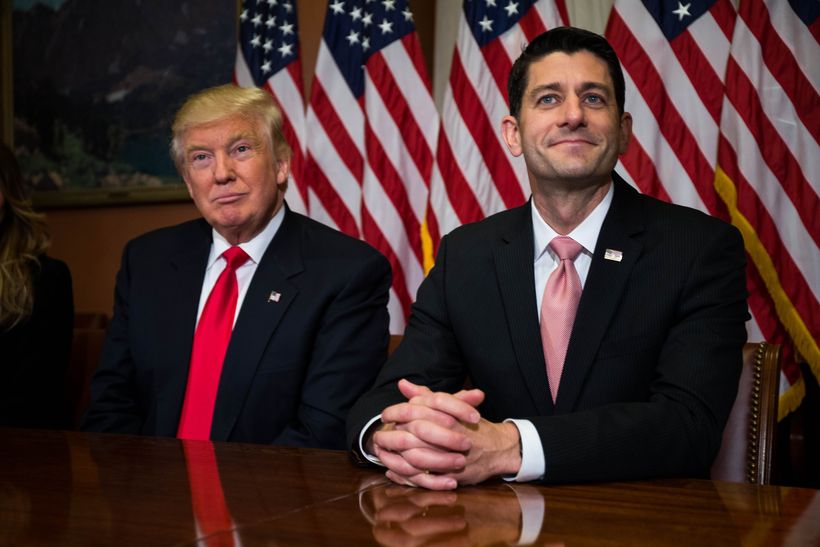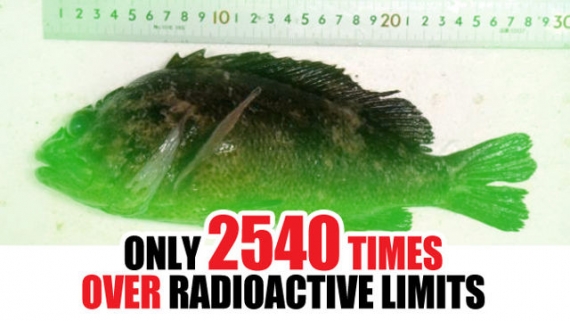Updated by David Roberts and Brad Plumer Nov 14, 2016, 9:21am EST
It’s not just Trump. Take a look at Congress. Photo by Zach Gibson/Getty Images
Unified Republican control of the federal government over the next two years augurs a sea change in US environmental policy like nothing since the late 1960s and ’70s, when America’s landmark environmental laws were first passed.
If Donald Trump and the GOP actually follow through on what they’ve promised, this time around will be a lurch in the opposite direction. Federal climate policy will all but disappear; participation in international environmental or climate treaties will end; pollution regulations will be reversed, frozen in place, or not enforced; clean energy research, development, and deployment assistance will decline; protections for sensitive areas and ecosystems will be lifted; federal leasing of fossil fuels will expand and accelerate; new Supreme Court appointees will crack down on EPA discretion.
Some of these moves will be easy for Trump and Republicans in Congress to pull off. Others will be harder: Senate Democrats and environmental groups in court will fight them tooth and nail, as they did during the Reagan and Bush years. But there’s no escaping the fact that the GOP is in a strong position to demolish and reshape the regime of environmental protection that has been built up over the past 50 years.
Never mind Trump — the GOP Congress has a radical environmental agenda ready to go
Donald Trump’s promise to dismantle President Obama’s climate regulations have gotten plenty of attention. But it is only the tip of the iceberg, a fraction of what Republicans in Congress have been pushing for over the years.
Obama has amassed a considerable record on green policy. His agencies have implemented a range of new standards and regulations on everything from appliances to cars to power plants, and he has stimulated the growth of several clean energy industries with loans and grants.
The GOP wants to undo all that. But it wants much more as well.
Few people understand just how radical the GOP environmental agenda is, but it’s not a secret. While Obama has been in office, Republicans in Congress have floated myriad budget bills that reveal their legislative priorities. Many of those bills were blocked by the Senate or White House, so they rarely got attention.
You can see a partial list of past House Republican bills here. In 2013, they proposed cutting EPA funding by fully one-third. GOP committees churned out bill after bill to cut research funding for renewable energy by 50 percent, block rules on coal pollution, block rules on oil spills, block rules on pesticide spraying, accelerate oil and gas drilling permits on public land, prohibit funding for creation or expansion of wildlife refuges, cut funding for the Advanced Technology Vehicle Manufacturing Loan Program, and … well, there are 61 items on the list.
The Senate GOP isn’t far behind: In 2015, they floated a bill to cut the EPA’s budget by 9 percent and block rules on everything from ground-level ozone pollution to climate change. There may be a few more moderate GOP senators who think global warming is a problem, like Susan Collins (R-ME). But they do not dominate the caucus: Fossil-fuel enthusiasts like Mitch McConnell and James Inhofe do.
There’s no indication that Trump will buck his party on these issues. His ignorance on policy is near total and he’s shown no desire or willingness to learn anything about it. So in practice, environmental policy under Trump is likely to be run by the GOP apparatus — Republican leaders in Congress and the industry-friendly figures he appoints to his administration. He’s already tapped climate denier Myron Ebell to lead the transition at EPA and is considering Sarah Palin (yes, really) to head the Department of the Interior.
There’s little reason to think that Trump’s environmental and climate policy will be some unpredictable, idiosyncratic anomaly like Trump himself. It will likely be standard, mainstream GOP policy, which is far more radical than anything he campaigned on.
The biggest thing slowing the GOP right now is the Senate filibuster
It won’t be easy for the Trump administration to roll back many of the EPA’s existing regulations on its own. As Jody Freeman, an Obama administration veteran, explains in detail here, rewriting existing regulations through the executive branch is an arduous process, one that’s almost certain to get bogged down in court by green groups skilled at litigation. Similar lawsuits ultimately stymied George W. Bush in the 2000s, and he only managed to rescind a fraction of Bill Clinton’s environmental rules.
So the biggest question is whether Republicans in Congress can revamp the laws that underpin and guide the EPA. And here, the only thing stopping them is the Senate.
There will be 47 Democrats in the Senate in 2017. If 41 of them can stick together, they can filibuster Republican environmental legislation. (Ending a filibuster requires a cloture vote by a supermajority of 60 senators.)
Will Republican leaders let that happen? Or will they get rid of the filibuster? They would need only 50 votes to do so. Jonathan Chait thinks the filibuster is toast. Jonathan Bernstein thinks there’s a chance it could survive, since there are some old-school institutionalists on the right, like Jeff Flake and John McCain, who prefer to keep it.
If the filibuster survives, Republicans will be significantly constrained in what they can do, though they still have options. They could, for instance, try to slip environmental measures that affect the federal budget into budget reconciliation bills — those only need 51 votes to pass. (Paul Ryan suggested that strategy in a presser in January.)
Here are 11 top environmental priorities for Trump and a GOP Congress
1) Kill Obama’s Clean Power Plan
The GOP is nearly united in its hatred of Obama’s signature climate policy, the Clean Power Plan. There’s only one Republican senator left, Susan Collins of Maine, who has ever defended it. Killing or degrading the CPP will be a top priority.
In 2007’s Massachusetts v. EPA, the Supreme Court ruled that greenhouse gases could, if judged dangerous to human health or welfare, be considered pollutants subject to the Clean Air Act. Shortly thereafter, EPA’s scientists judged them dangerous to both.
That means EPA must, by law, act to reduce greenhouse gases. The Obama administration followed through on this by enacting fuel economy standards for cars and light trucks (see below). It also set up the Clean Power Plan, which would reduce carbon dioxide emissions from existing power plants.
The simplest way for the GOP to destroy the CPP would be to take away the EPA’s ability to regulate greenhouse gases at all. It’s a simple bill: “The Clean Air Act shall not apply to greenhouse gases.” The CPP would be nuked, and no president could ever again try to do what Obama did. (The House passed just such a bill in 2011.)
If Senate Democrats can filibuster this measure — and this is likely to be a central fight — then the Trump administration would have to resort to other executive branch strategies to weaken the rule. It could refuse to defend it in court. It could deny EPA the funds necessary to enforce it. It could start another round of rulemaking to substantially weaken it. Those moves would inevitably prompt lawsuits, but those lawsuits would drag on for years and years.
One way or another, the CPP is in the crosshairs.
2) Withdraw from the Paris climate agreement
Back in 2015, the world’s countries got together in Paris and agreed to a landmark climate deal. Every country would voluntarily pledge to restrain its greenhouse gas emissions and meet regularly at the United Nations to ratchet up ambitions over time — all in the hopes of keeping global warming below the “dangerous” level of 2°C.
Now Trump plans to pull the United States out of the deal. His advisers are debating precisely how to do this, but there’s little stopping them. Trump can refuse to follow through on Obama’s pledge of cutting emissions 26 percent below 2005 levels by 2025. He can refuse to attend UN meetings, or refuse to chip in promised funds to help poor countries decarbonize.
The real question is how other countries will react. For now, the Chinese government is warning Trump not to blow up the deal and insisting that China will lead global efforts to curtail emissions in America’s absence. Still, there’s a real risk that other countries could lose interest in climate policy if the world’s wealthiest superpower bows out. David Victor, an expert on global climate policy at University of California, San Diego, explains how here.
Even under Paris, the world was struggling to stay below the 2°C global warming mark and had little margin for error. Now, with Trump’s recalcitrance, that goal has likely drifted out of reach.
3) Dismantle US environmental rules around coal power
Coal has always been the dirtiest, most carbon-intensive of fuels. Over the past eight years, Obama’s EPA has slowly ratcheted up environmental restrictions on air and water pollution from coal plants and mining activities.
Trump plans to ratchet them back down. Here’s his website: “We will end the war on coal, and rescind the coal mining lease moratorium … and conduct a top-down review of all anti-coal regulations issued by the Obama Administration.”
Trump’s vow to “end the war on coal” will start by killing the Clean Power Plan. But his administration has also vowed to scale back an EPA rule to limit ground-level ozone pollution, as well as an Interior Department rule to protect streams from coal-mining waste. As Freeman explains, it will be hard for Trump to rescind regulations that are already finalized without Congress, but he can certainly bog down implementation.
As for coal mining: About 40 percent of US coal supply comes from public land. For years, the federal government has leased that land to coal companies for below market value, with almost no competitive bidding. It amounts to a huge subsidy to coal companies. In January, the Obama administration implemented an immediate moratorium on new coal leases, as the program was examined to make sure it was fair to taxpayers and ecologically sensitive. Trump would end that moratorium.
The consultancy group Wood Mackenzie has a long list of other ideas Trump might pursue to aid the coal industry. Note that many of these steps would have limited impact: Coal plants have already made costly investments to curb mercury pollution, so scaling back that Obama rule wouldn’t do much. And Trump won’t save the coal industry from its biggest threat: the flood of cheap shale gas from fracking. There’s also little chance that mining jobs will make a major comeback, since automation has been the biggest driver of job losses there.
Coal production, consumption, and employment are all headed down, and likely to keep heading down regardless of what Trump does.
Still, Trump’s moves will, at the margins, make the coal industry more profitable. Note that Peabody Coal, the world’s largest coal company, saw its share price soar after Trump’s election.
4) Weaken fuel economy standards for cars and light trucks
The Clean Power Plan isn’t Obama’s only big climate policy. Ever since 2010, the Obama administration has been ratcheting up fuel economy standards for new cars and light trucks in an effort to cut carbon emissions and reduce US oil dependence. These CAFE standards are set to rise from their current 35 miles per gallon to 54.5 miles per gallon by 2025.
But those numbers aren’t set in stone. The CAFE rules come up for a scheduled review in 2018. Automakers are now lobbying for Trump to relax the standards, purportedly because sales of fuel-efficient vehicles have been sluggish due to low gasoline prices. While Trump hasn’t commented on this, he has plenty of leeway to weaken these rules.
The one twist here is that due to a longstanding quirk of the Clean Air Act, California can threaten to create its own stricter vehicle standards if it’s not happy with what the federal government is doing (and other states can join in). Automakers loathe the idea of multiple sets of vehicle standards around the country, which may prevent Trump from weakening the rules too much.
Meanwhile, some Republicans in Congress have been talking about getting rid of fuel economy standards altogether — through legislation. “You can make a good intellectual case to repeal CAFE and let the market handle it,” said Rep. Joe Barton (R-TX) at a House Energy Committee hearing in September. “If Mr. Trump is president … we’ll be back.”
5) Open up new public lands to oil and gas drilling
America has about 279 million acres of public land and waters with potential oil and gas. The government allows companies to drill on a little under half that acreage. But both Congress and the Obama administration have put the rest off limits over the years, often to protect fragile ecosystems or endangered species.
Trump has promised to open it all up. He often touts a study looking at the impact of allowing drilling on all federal lands currently off limits. Some of that Trump could do through executive actions, like lifting the Obama-era restrictions around oil drilling in Alaska or the Arctic Ocean or even parts of the Atlantic Coast. Opening up other regions, like the Arctic National Wildlife Refuge in Alaska, would require Congress.
Even if Trump does this, it’s still unclear how much drilling would actually occur. Oil prices are fairly low right now, which could make it risky for companies to drill in the most challenging areas, like Alaska’s Arctic seas (where Shell tried and failed to find oil). And a few states, like Florida, might put up a fight along their coasts.
It also doesn’t sound like Trump is going to be particularly finicky about oil spill protections, given that he’s pledged to “streamline the permitting process for all energy projects.” In case you’re curious, this is a good look at what an ecological nightmare an oil spill in the frozen Arctic would be.
6) Scale back federal support for wind and solar power
Greens like to tell themselves that renewable energy is already cheap enough to stand on its own, without policy supports, but for a variety of reasons, that isn’t really true. Wind and solar in the US have long relied on federal tax credits — the investment tax credit (ITC) for solar and the production tax credit (PTC) for wind.
The PTC has lapsed and been extended many times. This is what that inconsistency does to growth in wind power:
Both credits were widely expected to lapse last year, but in a somewhat miraculous last-minute deal in December, they were extended for five years, over which time they will slowly phase out.
This would have served as a kind of bridge for renewables, carrying them to the point when the Clean Power Plan kicks in. Now the CPP is likely toast. And the big question is whether Republicans in Congress might scale back the solar and wind credits.
There’s some reason to think they are safe for now. In Politico, an unnamed “major Trump financial contributor who said he is a member of the transition team” assures us that the ITC and PTC “will remain in place.” Then again, oil baron Harold Hamm, a key Trump energy adviser and rumored contender for energy secretary, recently said of solar and wind, “None of it should be subsidized, none of it. If it makes it in the market, fine.” So who knows?
Meanwhile, Trump has also talked about zeroing out all federal research and development for clean energy, which would include work the Department of Energy is doing on solar, wind, nuclear power, efficiency, electric cars, batteries, and more, including the cutting-edge research being done at ARPA-E.
In the past, House Republicans have shown an eagerness to scale back this research (though not, oddly enough, R&D for fossil fuels). A move like this could throttle the next generation of low-carbon technology.
7) Dramatically limit the EPA’s ability to regulate in the future
Most of the environmental policy progress in the US over the last 40 years has come through “green drift,” i.e., through agencies like the EPA adapting and expanding America’s foundational green laws — the Clean Air and Clean Water acts, the Endangered Species Act, the National Environmental Policy Act — to address new problems.
This occurs because those laws were written to be incredibly open-ended. They were designed to be flexible, to apply to whatever new threats agency scientists uncovered. The Clean Air Act tells the EPA to update its rules over time to reflect the best available science about the health impacts of pollution; the EPA does just that.
This process has always driven conservatives crazy. In part, they think the flexibility encourages executive overreach; in part, they just hate environmental regulations.
They have a way to put a stop to green drift. It’s called the REINS Act (Regulations From the Executive in Need of Scrutiny). It would mandate that every “economically significant” federal regulation — any rule that has an annual impact of $100 million or more — be affirmatively approved by the House and Senate and be signed by the president. If a regulation is not voted on within 70 legislative working days of being sent to Congress, it is “tabled.” That is, it dies.
This law would radically constrain EPA’s ability to issue new environmental regulations as situations and science evolved (to say nothing of what it would do to other federal agencies). It would be a fundamental change in the administrative state and a radical increase in Congress’s power relative to the president.
It would slow progress on all fronts, but on environmental policy, where there is such unified Republican antipathy, it would almost certainly result in a total freeze — no new substantial regulations as long as Republicans control any of the three branches of government.
The GOP House passed REINS several times during the Obama years, only to see it stripped out or blocked in the Senate. With a GOP Senate and Trump as president, there’s a very real chance it could become law.
8) Reverse the White House’s climate guidance to federal agencies
In August, the White House Council on Environmental Quality (CEQ) issued a somewhat obscure but extremely important guidance to other federal agencies. All agencies, when considering any new project, have to do a National Environmental Policy Act (NEPA) review to assess the project’s environmental impacts. CEQ’s guidance instructs agencies to consider direct and indirect climate impacts as part of those NEPA reviews.
And it clarifies that agencies should not ignore climate impacts merely because a single project might be a small fraction of global emissions — a position many agencies had been taking. The guidance says, effectively, that climate should matter in every federal decision. (More on the details of the guidance here.)
It has its inconsistencies, and did not carry the force of law, but the guidance was an important signal, the kind of background nudge that shifts the direction of the ship of state.
Trump has not specifically said he will rescind the guidance, but if he puts a clever industry lobbyist in charge of CEQ, it’s tough to see how it will survive. If it is rescinded, federal agencies are likely to go back to ignoring climate impacts.
9) Make the Supreme Court more hostile to environmental regulation
Conservatives, states, and businesses have sued against virtually every environmental regulation in the past 40 years. Very often, those suits have failed. Since the Supreme Court’s Chevron decision in 1984, the Court has given executive branch agencies wide latitude in how they write and implement rules to carry out congressional intent.
But that’s changing. The conservatives on the Court have been seeking to rein in executive agencies lately, especially after Obama, who built a progressive policy legacy almost entirely out of executive actions.
Trump will get to select at least one, and possibly up to four, Supreme Court justices, who are likely to be to Scalia’s right. For every justice he picks, the Court as a whole is likely to become more hostile to executive action, meaning that lawsuits against environmental regulations are likely to find a much more amenable venue in coming years.
10) Pack the executive branch with industry-friendly appointments
One thing that’s become very clear over the past few decades: When it comes to the federal government, personnel is policy. The people who staff and head executive branch agencies make a stream of daily decisions, the vast majority of which never rise to the level of public attention. Those agency decisions pile up over time. They can lead to steady, effective government or to incompetence and corruption.
George W. Bush legendarily stocked his government with industry executives, lobbyists, and cronies. Under his Interior Department, officials used to trade favors to the oil and gas industry for hookers and blow. (No, seriously.) Reports on the agency submitted to Congress “portray a dysfunctional organization that has been riddled with conflicts of interest, unprofessional behavior and a free-for-all atmosphere for much of the Bush administration’s watch.”
Under Bush’s EPA, meanwhile, administrator Stephen Johnson “suppress[ed] staff recommendations on pesticides, mercury, lead paint, smog, and global warming.” In Bush’s White House Council on Environmental Quality, James Connaughton denied global warming and defended the air quality in Lower Manhattan just after 9/11. Philip Cooney, also at CEQ, was busted doctoring scientific reports on climate change and left the administration to lobby for Exxon. FEMA had Michael Brown. The list could go on.
The kind of crude collusion between industry and government that characterized the Bush administration looks, from all indications, to be Trump’s model.
His pick to lead his EPA transition is Myron Ebell of the Competitive Enterprise Institute, mostly famous for his sheer persistence in denying climate change (he’s been at it since 2000). He recently said that “Congress should prohibit any funding for the Paris Climate Treaty, the Green Climate Fund, and the underlying UN Framework Convention on Climate Change.”
There are several more industry lobbyists on Trump’s energy and environment team; see Robin Bravender at ClimateWire for more.
11) A flurry of anti-EPA budget bills that will emerge every year, without end
The above list is by no means exhaustive. Trump has also indicated that he would like to repeal the EPA’s Waters of the United States rule, which would limit the number of rivers, streams, and lakes that fall under the Clean Water Act. The oil and gas industry is already eager to kill Obama-era rules to plug leaks of methane, a potent greenhouse gas, from pipelines and wells.
Meanwhile, in the House, Republicans have a whole flurry of anti-EPA bills they’re eager to push forward, and they will try to attach these “riders” to must-pass budget and spending bills at every turn.
In 2015, there were riders to prevent the federal government from updating its flood-map plans to incorporate climate change forecasts. Riders to block the EPA from even researching the environmental impacts of fracking. Riders to halt upgrades to wastewater management systems. Riders to block the Department of Energy’s efforts to improve climate change modeling and forecasts. Riders to hinder citizens from suing the federal government if it falls down on the job of enforcing the Clean Water Act. You can check out the full smorgasbord here.
Resistance will be fierce, but it lacks leverage
Climate and environmental groups will not simply sit back and watch this happen. “If Donald Trump thinks he can launch a big polluter assault on our air, waters, wildlife and lands,” said Rhea Suh, president of the Natural Resources Defense Council, in a statement, “we’ll build a wall of opposition to stop him.”
In politics, every action has an equal and opposite reaction. An assault on environmental laws and regulations will spark fierce, organized resistance, just as it did during the Bush years. Many of the internal squabbles within the climate community — carbon tax or cap and trade? research or deployment? — will rapidly come to seem quaint. The stakes will be higher, the sides clearer.
But there’s no getting around it: The victories will be fewer. Even during the Bush years, the environmental community had more to work with, including an occasionally Democratic Senate and a few old-fashioned Republicans who cared about local pollution. (Oh, and the filibuster.)
Now it has none of those. The GOP controls the House, the Senate, the presidency, the Supreme Court, and, soon enough, lower courts. If Republicans kill the filibuster, they will be virtually unrestrained at the federal level, limited only by their ability to overcome infighting and internal disagreement (which, admittedly, is no small thing). The 2018 Senate map is incredibly favorable to Republicans, and right now they look poised to strengthen their majority in the midterms.
The GOP also dominates at the state level, controlling 68 out of 99 state legislative chambers (both chambers in 33 states) and 32 governors’ mansions.
What’s more, the GOP has become much more radicalized since the Bush years, and the country much more partisan. “Negative partisanship” — hatred of the other side — is increasingly the prime motive force in US politics, with less and less willingness on either side to compromise or even negotiate. There is virtually no Republican support left for environmental or climate policy, other than to dismantle it.
While there is always some chance Trump could lunge off in an unexpected direction (he is Trump, after all), the overwhelming likelihood is that GOP operatives and industry lobbyists will control energy and environmental policy for the next four years. What lies ahead now is triage, a long string of terrible choices, desperate battles, and wrenching losses, the consequences of which could reverberate for millennia.















